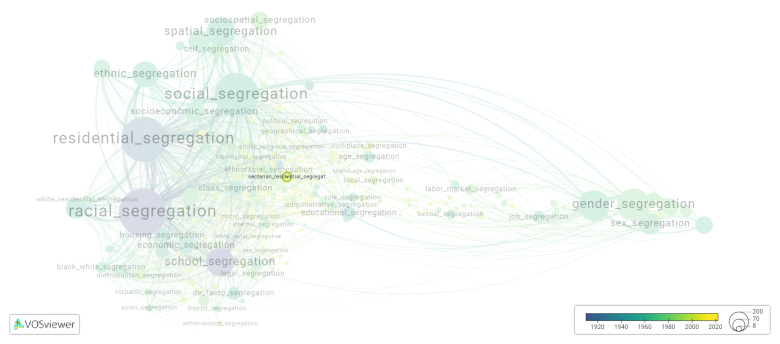Sectarian residential segregation: Difference between revisions
(Creating page) |
(Creating page) |
||
| (2 intermediate revisions by the same user not shown) | |||
| Line 18: | Line 18: | ||
[[File:sectarian_residential_segregation.png|780x780px]] | [[File:sectarian_residential_segregation.png|780x780px]] | ||
This visualization is based on the study [[Segregation_Wiki:About| The Multidisciplinary Landscape of Segregation Research]]. | |||
For the complete network of | For the complete network of interrelated segregation forms, please refer to: | ||
* [https://tinyurl.com/2235lkhw First year of publication] | |||
* [https://tinyurl.com/2d8wg5n3 Louvain clusters] | |||
* [https://tinyurl.com/223udk5r Betweenness centrality] | |||
* [https://tinyurl.com/244d8unz Disciplines in which segregation forms first emerged (Scopus database).] | |||
==References== | ==References== | ||
==Notes== | ==Notes== | ||
Latest revision as of 07:17, 16 October 2024
Date and country of first publication[1][edit | edit source]
2006
United Kingdom
Definition[edit | edit source]
Sectarian residential segregation refers to the separation of residential areas based on religious or sectarian affiliations. It is characterized by the clustering of individuals from the same religious or sectarian group within certain neighborhoods or regions, leading to a lack of integration and interaction between different religious communities.
Sectarian residential segregation can occur for various reasons, including historical conflicts, political divisions, and cultural or religious differences. In some cases, it may be a result of deliberate policies or actions by governments or religious organizations to promote homogeneity and preserve the identity of specific religious groups.
This type of segregation can have significant social, economic, and political implications. It often perpetuates social inequalities, further divides communities, and can fuel tensions and conflicts between different religious groups. It may also lead to limited access to resources and services for residents in segregated areas, such as education, healthcare, and job opportunities.
Efforts to address sectarian residential segregation typically involve promoting integration and inclusivity through policies and initiatives that encourage mixed-use development, interfaith dialogue, and shared public spaces. However, overcoming such segregation requires long-term commitment and advocacy from various stakeholders, including governments, religious leaders, and community organizations.
See also[edit | edit source]
Related segregation forms[edit | edit source]
Sectarian residential segregation is frequently discussed in the literature with the following segregation forms:
This visualization is based on the study The Multidisciplinary Landscape of Segregation Research.
For the complete network of interrelated segregation forms, please refer to:
References[edit | edit source]
Notes[edit | edit source]
- ↑ Date and country of first publication as informed by the Scopus database (December 2023).
At its current state, this definition has been generated by a Large Language Model (LLM) so far without review by an independent researcher or a member of the curating team of segregation experts that keep the Segregation Wiki online. While we strive for accuracy, we cannot guarantee its reliability, completeness and timeliness. Please use this content with caution and verify information as needed. Also, feel free to improve on the definition as you see fit, including the use of references and other informational resources. We value your input in enhancing the quality and accuracy of the definitions of segregation forms collectively offered in the Segregation Wiki ©.
Sectarian residential segregation appears in the following literature[edit | edit source]
Healy J. (2006). Locality matters: Ethnic segregation and community conflict The experience of protestant girls in belfast. Children and Society, 20(2), 105-115. https://doi.org/10.1111/j.1099-0860.2006.00018.x

